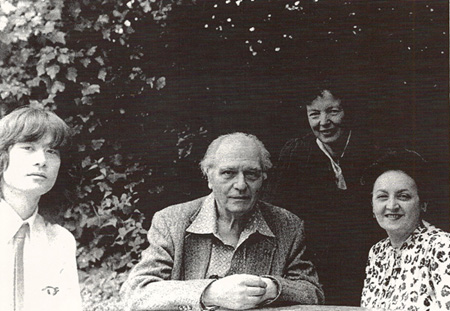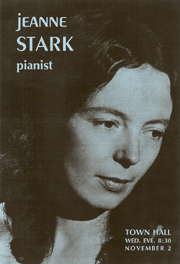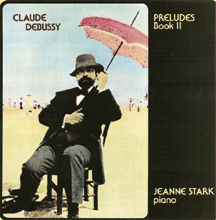|
Phoenix Pasticceria, one of Berkeley, California's hot spots, is a tiny pasta café-bakery in the "gourmet ghetto" near campus. Apart from offering an exotic array of fresh pasta and the best bread in town, the café displays a few intriguing musical offerings: CDs by a certain Belgian pianist, Jeanne Stark-Iochmans. Together with my bread and pasta I acquired the Goldberg Variations and was amazed by the distinct musicality and tenderness of Stark-Iochman's interpretation. Next I tried the CD of her Debussy Etudes and was bewitched by her essentially "French" elegance and sophistication. Then I was blown away by the powerful sense of a spiritual, existential testament in her recent CD of Beethoven's Last Three Sonatas, Op. 109, 110, and 111. I learned that the owner of the Pasticceria was the son of the pianist, that she lives in Berkeley, teaches the piano and occasionally – in chosen places and contexts – gives a concert. When I heard that every one of these special performances would be prepared for months by the pianist my curiosity was piqued. This sounded like a by-gone era – the golden age when operas like Wagner's Ring in Bayreuth with Pierre Boulez and Patrick Chéreau were rehearsed for a whole year.
I have since heard Jeanne Stark-Iochmans perform a number of times. The most recent concert (sponsored by Four Seasons Concerts) took place on Feb. 19th at the stately San Francisco Herbst Hall. The program offered an uncanny musical arc from Mozart's Sonata in C Major to two Chopin Ballades and culminated in Ravel's Gaspard de la Nuit.
Mozart's Sonata in C Major (K 330) came as a surprise to me as if I had never heard it before. Not only did Stark-Iochmans play all the repeats, she played the piece a touch more slowly than it is often played, coaxing secret, soulful legatos from underneath the dancing, playful crispness of her playing. The slow second movement reached such a soulful depth that one could feel a spell fall over the packed theater. If I were the composer, I thought – if I were Mozart, I would be delighted to be met and recognized in such a way that the audience stops breathing for a moment ... and I could hear my own music as a discovery.
In Chopin's ballades, Stark-Iochmans again seemed to attend to the weight of every single note. In Ballade No. 1 in G minor, opus 23, with its halting waltz rhythms and peaks of exuberance, it became clear that the artist's virtuosity, speed and power did not come at the price of clarity; the architecture of the ballade appeared with a transparent luster. At the same time she drew out the melancholy mood that is so endlessly compelling in Chopin's music – the loss of something in the past, something angelic, one might say, which in Stark-Iochmans' playing created a touching link back to Mozart's Sonata.
Ballade No. 2 in F Major, opus 38 reverses the traditional form of the central lyrical part: the childlike purity of an idyll is followed by agitation and sorrow, violent upheaval and destruction. The theme of innocence returns again like a haunted echo, a plea before its fading and ultimate loss, dislocated from its original key. In Stark-Jochman's rendition this "remembrance of things past" replaced any hint of sentimentality with unsuspected feeling. I watched the audience (and myself) walk out into the intermission, somewhat hushed and shaken by the experience.
During intermission I wondered (as I had every time I heard her play), why Jeanne Stark-Iochmans' name is not among the famous performers of the past decades? Why are her recordings not available at every classical record store?
Her artistry had been praised by composers like Darius Milhaud, Olivier Messiaen, Lou Harrison, and by conductors like Kent Nagano. She had been a wunderkind of Belgian piano playing. In 1945, at the Royal Conservatory of Brussels, she was the first student in 20 years to graduate with the coveted Prix de Virtuosité avec Grande Distinction and a gold medal from the Belgian government. She won the Laure Van Cutsem National Prize and was chosen to represent her country at a festival of modern music in Bayreuth. A scholarship from the International Queen Elizabeth Competition brought her to the US: allowed to choose a teacher anywhere in the world, she chose to study with Mieczsyslaw Horszowsky in Philadelphia and afterwards with Edwine Behre in New York and Vermont.

Kent Nagano, Olivier Messiaen, Jeanne and Yvonne Loriod
Her career (under the name of her first husband, as Jeanne Sartenaer) took off with applauded concerts at Carnegie Hall and Alice Tully Hall, but it turned out that the hectic schedule of touring the world was not the artistic life she envisioned. Instead,  the slender young woman with the face of a Flemish madonna went into a self-willed seclusion from the "circuit" of concert fashion and fame. She developed her own intimate network of musician friends and producers who recognized her as a different kind of artist – an artist with her very own approach and need for spiritual depth in musical perfection. the slender young woman with the face of a Flemish madonna went into a self-willed seclusion from the "circuit" of concert fashion and fame. She developed her own intimate network of musician friends and producers who recognized her as a different kind of artist – an artist with her very own approach and need for spiritual depth in musical perfection.
In the late sixties and seventies, Jeanne Stark (now using her second husband's name) had moved to California where she collaborated and toured with violinist and conductor Anne Kish, the founder of the Berkeley orchestra "School of Orpheus." The opening concert took place at Cody's, Berkeley's main bookstore, and was attended by Darius Milhaud. Soon afterwards, Stark-Iochmans worked with Germain Prevost (of the famed Pro Arte Quartet) on Milhaud's Viola and Piano Sonatas. Also in the seventies, she repeatedly performed with Kent Nagano at the Berkeley Symphony and appeared at Tom Buckner's 1750 Arch Concerts in the San Francisco Bay Area;  Buckner released her recordings of the complete Preludes (Book I and II) of Claude Debussy. Buckner released her recordings of the complete Preludes (Book I and II) of Claude Debussy.
In the eighties and nineties, the steadfast backing she needed to continue at her own pace was provided by the Founder and Director of "Today's Artists" and "Four Seasons Concerts", Hazaiah Williams, who brought her back to New York for Carnegie Hall and Alice Tully Hall recitals. Recently the pianist brothers Richard and John Contiguglia invited her to join the Bozeman Symphony Piano Recital Series of the Adams Foundation – a foundation "designed to reestablish piano recitals in communities throughout America."
It's a refreshing thought that communities throughout America might discover this acclaimed artist who had chosen to remain a well-kept secret. The Musical Director of WNYC, Herman Newman, once commented, "Her Debussy and Ravel are the best I have heard since Gieseking."
What he meant was vividly demonstrated in the second half of the program.
Stark-Iochmans had provided her audience with her own translation of the pre-symbolist poems by Aloysius Bertrand that were Ravel's inspiration for the three parts of Gaspard de la Nuit – "Ondine," "Le Gibet (The Gallows)," and "Scarbo." In 1908, Ravel created these tone poems, modern musical illustrations of texts that are whimsical, moody and fantastical. All of them demand not only great virtuosity, most of all they beg for color – the very element the piano refuses to render unless a true musician breaks through the resistance of the instrument.
"Ondine" sings to court a mortal man: "...each current is a path to my palace and my palace lies invisible at the bottom of the lake in the triangle of fire, earth and air. / Listen! Listen! My Father beats the water with a branch of green willows and my sisters stroke the islands with their arms of fresh foam.(...)" The poet concludes: "And as I answered that I loved a mortal, she sulked for a moment, cried a few tears... burst into peals of laughter and vanished in showers of white rain along my blue windows."
I would swear that I heard every imaginable shade of green, blue and violet among the splendid, shimmering colors of water and light that Stark-Iochmans brought out in this first piece, before giving way to the dark sighing moods and sinister colors of "The Gallows":
"It is the bell that tolls inside the walls/ of a city far off under the horizon/ and the body of a hanged man/ in the red sunset."
More color and tonal magic followed with the surreal "Scarbo," a creature right out of E.T.A. Hoffman's "Night Tales":
"Oh how often have I heard and seen/ him, Scarbo, when at midnight/ the moon, like a silver coin, shines/ in the sky on a banner of blue/ sprinkled with golden gems.
"How often have I heard the buzz/ of his laughter in the shadow of my/ alcove and the grating of his nails/ on the silk spread of my bed!
"How often have I seen him down on/ the floor, pirouetting on one foot/ and rolling around the room like/ a witch's spindle!
"Did I think that he fainted? No, the gnome would grow and / stretch himself between the moon/ and me like the steeple of a/ cathedral, a little bell ringing/ on his pointed cap.
"But then his body would turn blue/ and his face ghastly like the/ wax of a candle and suddenly/ he was...no more."
"Scarbo," with its complicated rhythms, leaps and wild runs is a fabulous technical challenge to the player. The excitement of the music, the beauty and daring of the playing electrified the audience. I experienced Stark-Iochmans' intensity of concentration that I have often marveled about: she doesn't allow for anything "extra" in her playing; her laser-like focus is on the essential musical intention. The result of hearing her in concert is the shock that such a "youthful" energy and exuberant force of feeling can meet with timeless clarity, the simplicity of wisdom.
Afterwards, when Jeanne Stark-Iochmans came out to meet her audience she asked , "Which piece, do you think, is the most difficult?" Before I could decide, the pianist with decades of mastery answered her own question:
"The Mozart," she said, with a knowing smile. "The Mozart, of course."
Jeanne Stark-Iochmans can be heard on Arch Records' label with Debussy's Preludes, Books Iand II. Her CD recordings of Bach's Goldberg Variations, of Beethoven's Last Three Sonatas, Op. 109, 110 and 111, of Debussy's Etudes and Preludes, Book II can be ordered from Amoeba Music in Berkeley: Tel. (510) 549-1125.
|